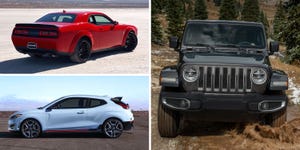View Photos

Dave HawkinsCar and Driver
From the June 1982 issue of Car and Driver.
The guys who built the new Firebird and Camaro are right. Rear-wheel drive is worth saving. That instant when the rear wheels search for traction and you correct the slide with a twitch of the steering wheel makes driving worthwhile. Front-wheel drive is for Nervous Nellies. After all, if maximum traction were the essence of greatness in automobiles, we’d all be driving Pinzgauers.
The funny thing is, it’s a Toyota Celica that provides this realization, not a Chevy Camaro. Celicas aren’t just little-bitty Camaros anymore. They are Camaros now, in performance as well as appeal. Think of the Celica Supra as a Z28. Think of a Celica GT as a civilian Camaro. And think of this new Celica GT-S as a special-edition Camaro—a breed that Chevrolet invented but has had trouble perpetuating because of its shrinking bankroll.
Performance is the primary objective of this Celica’s $990 S package. In fact, performance has become the primary objective of Toyota, too. Toyota reckons that performance will be what distinguishes one car manufacturer from another once they all reach fuel-economy parity. The GT-S is one part of an overall strategy that includes the Supra, a team of Celica race cars built by Dave Kent, twenty GT-S celebrity race cars, and plans for a catalog of race parts available through any Toyota dealership.
Toyota defines performance as something less than outright speed, though. Good handling is the keynote, backed up by sophisticated creature comforts and complemented by fuel efficiency and a low price. That’s a difficult target to hit, but Toyota has done the job here just by pouring all the good stuff from the Supra into the GT-S.
The Supra’s fender flares and wide tires give the Celica a powerful new demeanor right away. It looks squat and serious instead of simply stubby. It’s even hard to tell the GT-S from a Supra, since both cars are identical aft of the A-pillar.
The S package makes you feel a lot differently about the interior of the Celica, too. That’s because the sports seats from the Supra are bolted in place. Every possible bolster on this seat is adjustable, and the lumbar support even incorporates three small, inflatable bags. Between this seat and the tilt steering wheel, it isn’t Toyota’s fault if you can’t get comfortable.
In concert with Toyota’s definition, all the performance stuff is under the fenders, not in the engine compartment. After eleven years of fine-tuning, the Celica’s suspension is already pretty wonderful. Offset springs make the front MacPherson struts more responsive to small bumps this year by reducing mechanical friction. The front track has been widened 1.8 inches, and 1.5 degrees of caster have been added to the alignment settings to increase directional stability. It’s a good suspension made even better with the pieces from last year’s Supra sports model that have been folded into the S package: 50 percent stiffer springs, front shocks with 66-percent tighter compression damping, rear shocks with 36-percent softer compression damping, and a 3mm-larger front anti-roll bar and a 2mm-smaller rear one. Mix in the new Supra’s 225/60HR-14 tires on 7.0-inch-wide cast-aluminum wheels, and you’ve got a car with some pretty serious handling.
These changes completely alter your impression of the car. Suddenly the Celica likes to do tricks. It still understeers at the limit, but it’s far more neutral than before. Hurl it into a corner as fast as you dare; the GT-S won’t sink to its bump rubbers in terror. Both ends of the car work together to provide grip on the order of 0.77 g. Only the controls hold you back: the brakes are overboosted and therefore hard to modulate, while the variable-assist rack-and-pinion steering (an option required by Toyota with the S package) doesn’t provide much feedback.
Even so, the low-effort controls help give the GT-S a dimension of daily commute pleasantness that most performance cars don’t have. Observed fuel economy from the 2.4-liter inline-four is 23 mpg on the C/D scale, boosted this year with 8 percent taller transmission ratios in the first four gears. Only the ride suffers in comparison with the standard Celica, though it’s acceptable over anything but bomb craters.
The one thing that keeps us from falling over ourselves in praise of the GT-S is its engine. Again, eleven years of fine-tuning have made Toyota’s 22R engine pretty nice on the freeway. It idles along at a bit over 2000 rpm at cruising speed, and responds quickly to a prod on the gas, thanks to minimal flywheel inertia. But it doesn’t feel happy in its work the way the Supra’s six-cylinder does. Just like the four-banger in the Camaro, the Celica’s engine rattles and drones terribly at more than 4000 rpm. Above the 5000-rpm mark, it threatens to jump out of the engine compartment.
Basically, the engine just isn’t up to the fun quotient of the suspension. When you wrap it all up, though, the Celica GT-S seems just like the car Chevrolet hoped its four-cylinder Camaro would be, just as the Supra is the car Chevy hoped the Z28 would be. Fortunately for Chevrolet, it’s got a sizable price advantage on its side in both departments. As far as Toyota is concerned, the GT-S is good enough to make you think twice about a Supra, since it costs $4933 less, weighs 390 pounds less, gets six more miles per gallon, and does the quarter-mile in a relatively quick 18.2 seconds at 75 mph. Toyota figures, though, that the 1400 GT-S models scheduled to hit the streets every month will help sell the 10,000 Celicas slated for sale during the same period, rather than steal customers away from the monthly 2800 Supras.
If you like to slide your car around in the corners, rear-wheel drive is still the way to go. And the Celica GT-S does the job so sensibly and so comfortably that the proponents of rear-drive now have yet another compelling argument in their favor.
This content is created and maintained by a third party, and imported onto this page to help users provide their email addresses. You may be able to find more information about this and similar content at piano.io











